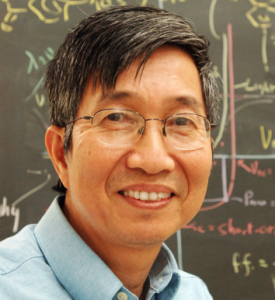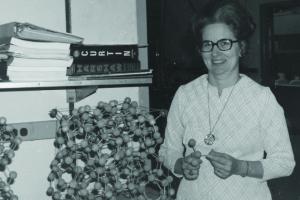
When you check an image on your smart phone, or enjoy the evolving clarity of modern television screens, you can thank Ching Tang,
Professor of chemical engineering at the
University of Rochester-- and patron saint of nearsighted sports-bar customers worldwide. He invented the organic light-emitting diode (OLED) technology that is so vital to the stunning images we take for granted everyday.
On May 29, standing solemnly in the well of the Israeli
Knesset in Jerusalem, Ching Tang shared the
$100,000 Wolf Prize with two other scientists in the field of chemistry. The annual prize, which honored the researchers for contributions to the synthesis and understanding of organic materials, was awarded by the
Wolf Foundation. It is widely considered only second in prestige to the
Nobel Prize. When handicapping the Noble, winners are always considered serious contenders with 1-in-3 odds--Vegas oddsmakers call it the Wolf Bump.
Finally back in the US, Professor Tang admitted the thrill he gets inventing something that billions of people use every day, telling a local Rochester TV reporter (
click to see report), "The fact that I can hold it my hand to call my wife, daughter, son. It's fun, to be able to use your own invention." (Although most parents regret that he never had the foresight to include a remote kill switch).
He now holds more than 70 U.S. patents
When he published his seminal paper on the technology in 1987 in the journal
Applied Physics Letters, Tang worked at the
Eastman Kodak Company. His paper has been cited by more scientists than any other paper in the history of the well-regarded journal.
In addition to the discovery of
OLEDs, Tang has been credited with a number of key innovations

leading to the commercialization of new flat-panel display technology, including the development of robust luminescent materials, novel color pixilation methods, fabrication processes for the manufacture of OLED displays, and the adaptation of technology for high-definition OLED displays. He now holds more than 70 U.S. patents and has published 70 papers.
Tang shared the 2011 prize with Professor Stuart Alan Rice of the
University of Chicago, and Professor Krzystof Matyjaszewski of
Carnegie Mellon University. Three cheers to a visionary man with
Bladerunner aesthetic long before anyone thought it possible.
 When you check an image on your smart phone, or enjoy the evolving clarity of modern television screens, you can thank Ching Tang, Professor of chemical engineering at the University of Rochester-- and patron saint of nearsighted sports-bar customers worldwide. He invented the organic light-emitting diode (OLED) technology that is so vital to the stunning images we take for granted everyday.
On May 29, standing solemnly in the well of the Israeli Knesset in Jerusalem, Ching Tang shared the $100,000 Wolf Prize with two other scientists in the field of chemistry. The annual prize, which honored the researchers for contributions to the synthesis and understanding of organic materials, was awarded by the Wolf Foundation. It is widely considered only second in prestige to the Nobel Prize. When handicapping the Noble, winners are always considered serious contenders with 1-in-3 odds--Vegas oddsmakers call it the Wolf Bump.
Finally back in the US, Professor Tang admitted the thrill he gets inventing something that billions of people use every day, telling a local Rochester TV reporter (click to see report), "The fact that I can hold it my hand to call my wife, daughter, son. It's fun, to be able to use your own invention." (Although most parents regret that he never had the foresight to include a remote kill switch).
When you check an image on your smart phone, or enjoy the evolving clarity of modern television screens, you can thank Ching Tang, Professor of chemical engineering at the University of Rochester-- and patron saint of nearsighted sports-bar customers worldwide. He invented the organic light-emitting diode (OLED) technology that is so vital to the stunning images we take for granted everyday.
On May 29, standing solemnly in the well of the Israeli Knesset in Jerusalem, Ching Tang shared the $100,000 Wolf Prize with two other scientists in the field of chemistry. The annual prize, which honored the researchers for contributions to the synthesis and understanding of organic materials, was awarded by the Wolf Foundation. It is widely considered only second in prestige to the Nobel Prize. When handicapping the Noble, winners are always considered serious contenders with 1-in-3 odds--Vegas oddsmakers call it the Wolf Bump.
Finally back in the US, Professor Tang admitted the thrill he gets inventing something that billions of people use every day, telling a local Rochester TV reporter (click to see report), "The fact that I can hold it my hand to call my wife, daughter, son. It's fun, to be able to use your own invention." (Although most parents regret that he never had the foresight to include a remote kill switch).
 leading to the commercialization of new flat-panel display technology, including the development of robust luminescent materials, novel color pixilation methods, fabrication processes for the manufacture of OLED displays, and the adaptation of technology for high-definition OLED displays. He now holds more than 70 U.S. patents and has published 70 papers.
Tang shared the 2011 prize with Professor Stuart Alan Rice of the University of Chicago, and Professor Krzystof Matyjaszewski of Carnegie Mellon University. Three cheers to a visionary man with Bladerunner aesthetic long before anyone thought it possible.
leading to the commercialization of new flat-panel display technology, including the development of robust luminescent materials, novel color pixilation methods, fabrication processes for the manufacture of OLED displays, and the adaptation of technology for high-definition OLED displays. He now holds more than 70 U.S. patents and has published 70 papers.
Tang shared the 2011 prize with Professor Stuart Alan Rice of the University of Chicago, and Professor Krzystof Matyjaszewski of Carnegie Mellon University. Three cheers to a visionary man with Bladerunner aesthetic long before anyone thought it possible.





